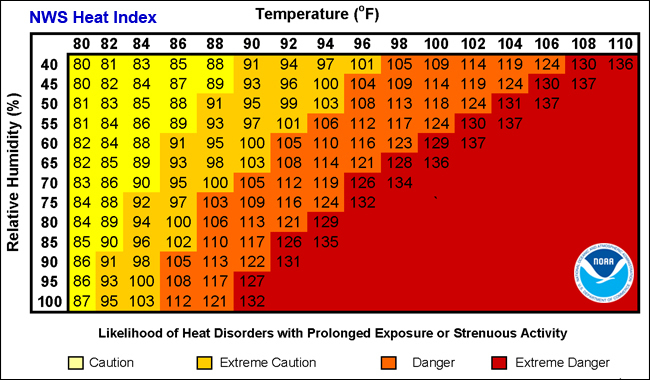Risk of warming temperatures is exacerbated by the increase of heat waves
When scientists warn us about the dangers of global warming, we typically think of increasing average temperatures steadily reaching the deadly threshold of a 1.5-degree Celsius increase that will set off an irreversible chain reaction of catastrophes (1). However, a potentially more dangerous marker of climate change also looms: heat waves. Though no formal definition of a heat wave exists, it is generally considered to be any abnormally long time period with elevated temperatures. As the number of extreme temperature events grows yearly, so does the damage caused to the health, jobs, and lives of countless people (2).

Abnormally high temperatures, coupled with humidity, can cause heat stress, heat exhaustion, and eventually heat stroke. These conditions, when left untreated, can interfere with an individual’s health and even lead to death. Under normal circumstances, the hypothalamus works with sweat ducts and glands to regulate the temperature of the body (3). When too hot, a person secretes sweat, which cools him or her down as it evaporates. In times of extreme temperature and humidity, however, the sweat does not evaporate, thereby nullifying the cooling response. This can cause heat cramps, which, if left untreated, can progress to heat exhaustion, then heat stroke (4). If a person’s internal temperature reaches 104 degrees Fahrenheit or higher, they will require urgent medical attention.
Extreme temperatures do not just affect the health conditions of individuals; they can also make it more difficult for farmers and outdoor workers to do their jobs. Unexpectedly high heat, especially early in the growing season, can cause a “false spring,” in which plants defrost and grow early in the spring. Because plants calibrate their systems to expect warmer weather, they are frequently killed by cold weather later in the season. The unusual heat of March 2012, for example, caused crops to bloom before they were fully developed, which led to a decline in food production (2). Excess warmth also melts frost early, making the natural calendar even less predictable and hurting farmers who must adjust for erratic planting seasons (5). Finally, outdoor laborers are at elevated risk of heat stroke and other hazards as the number of extreme temperature events increases (6).
Like many phenomenons related to climate change, extreme heat events disproportionately affect the already disadvantaged. Temperature increases are felt more within urban areas, due to dense population and the prevalence of materials that absorb heat, such as concrete and pavement. Racial minorities and those with lower incomes tend to live in these areas and suffer heat exhaustion and stroke more frequently than those in rural areas (7). Additionally, in areas with high ozone levels, the stillness of the air after a heat wave can lead to an increase in air pollution, which may worsen the health of those who live in cities (8).
As we increasingly feel the effects of climate change, extreme heat events will stand out as dangerous occurrences that further threaten the lives of people everywhere. If our bodies cannot regulate themselves, and plants respond to skewed signals, more and more heat-related deaths will occur.
– Julia Shephard
References
- Resnick, B. (2019, May 23). The limits of ancestry DNA tests, explained. Vox. Retrieved from
- Watts, J. (2018, Oct 8). We have 12 years to limit climate catastrophe, warns UN. The Guardian. Retrieved from https://www.theguardian.com/environment/2018/oct/08/global-warming-must-not-exceed-15c-warns-landmark-un-report
- The Union of Concerned Scientists. (2019, July). Killer Heat in the United States. UCSUSA. Retrieved from https://www.ucsusa.org/sites/default/files/attach/2019/07/killer-heat-analysis-full-report.pdf
- N.A. (2017, Dec 14). Heat exhaustion. Mayo Clinic. Retrieved from https://www.mayoclinic.org/diseases-conditions/heat-exhaustion/symptoms-causes/syc-20373250
- N.A. N.d. How the Body Regulates Heat. Rush University. Retrieved from https://www.rush.edu/health-wellness/discover-health/how-body-regulates-heat
- Meyer, R. (2017, March 1). What’s Dangerous About An Early Spring. The Atlantic. Retrieved from https://www.theatlantic.com/science/archive/2017/03/how-bad-is-an-early-warm-spring-climate-change/517992/
- N.A. N.d. Heat Stress. Iowa State University. Retrieved from https://www.ehs.iastate.edu/services/occupational/heat-stress
- Yang, S. (2013, May 14). Racial minorities live on the front lines of heat risk, study finds. Berkeley University. Retrieved from https://vcresearch.berkeley.edu/news/racial-minorities-live-front-lines-heat-risk-study-finds
- N.A. (2016, Oct). Climate Change and Extreme Heat: What you can do to prepare. Environmental Protection Agency. Retrieved from https://www.epa.gov/sites/production/files/2016-10/documents/extreme-heat-guidebook.pdf
Images






Be First to Comment